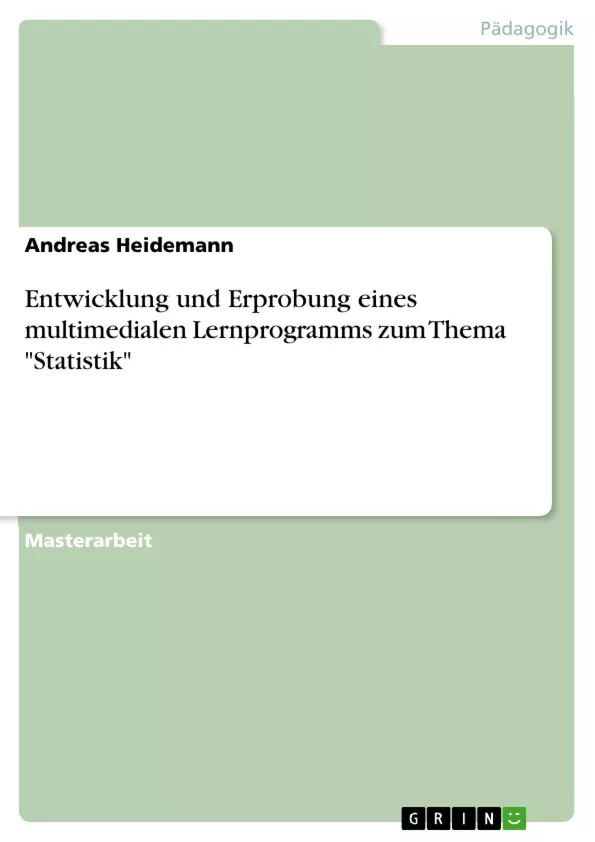Studien zeigen, dass sowohl Studierende, als auch Dozenten Probleme beim Verständnis des Signifikanzbegriffs aufweisen. Vor allem bei Studienanfängern mit geringem Vorwissen sind konventionelle Statistikbücher ungeeignet, da deren didaktische Gestaltung für diese Zielgruppe unzureichend ist und sich multimedial auf Texte und Graphiken beschränkt. Multimediale computerbasierte Lernpro-
gramme bieten hingegen eine Vielzahl didaktischer Gestaltungsmöglichkeiten, ein hohes Maß an Interaktivität, Adaptivität und Individualisierbarkeit. Dadurch wird der Lernprozess effektiver, effizienter und der Lernende erlebt während dessen größere Zufriedenheit. Empirische Untersuchungen bezüglich computerbasierter Statistik-Lernprogramme bestätigen dies. Im Rahmen der vorliegenden Arbeit wird ein CBT zur "Logik des Signifikanztests" didaktisch konzipiert und mit dem Autorenwerkzeug "Matchware Mediator 9" umgesetzt. Im Anschluss wird der Prototyp einem Usability-Test unterzogen, der Probleme bei der Benutzung aufdecken soll.
Schlüsselwörter: Multimediales Lernen, Signifikanztest, Lernprogramm, didaktische Konzeption, CTML, DO-ID-Modell, Usability-Test
Abstract
Studies show that students, as well as lecturers have problems with the understanding of the significance concept. Above all with undergraduate students with less basic knowledge conventional statistics books are inexpedient, because their
didactic conception is insufficient for this target group and limits itself multimedia to texts and graphics. However, multimedia computer-assisted instruction offers a huge number of didactic possibilities of conception, a high degree of interactivity,
adaptivity and individualisation opportunities. The learning process is thereby more effectively, more efficiently and the learner experiences during this higher satisfaction. Empiric research regarding computer based statistics programs con-
firms this. Within the scope of the present work a CBT is conceived to the "logic of the significance test" didactically and assembled with the author's tools "Matchware Mediator 9". Subsequently the prototype is submitted to a usability
test which should uncover problems with the use.
Key words: Multimedia learning, significance test, computer-assisted program, didactic conception, CTML, DO-ID Model, usability test
Inhaltsverzeichnis
- Einleitung
- Notwendigkeit eines Lernprogramms
- Notwendigkeit eines multimedialen CBT's
- Vorteile von CBT's gegenüber klassischen Printmedien
- Theoretische Grundlagen multimedialen Lernens
- Definition Lernen
- Das Arbeitsgedächtnis — Modelle von A. Baddeley & R. Mayer
- Cognitive Load Theorie
- Didaktische Konsequenzen für die Konzeption eines CBT's
- Reduktion der intrinsischen Belastung
- Reduktion der extrinsischen Belastung
- Modalitäts-Effekt und andere Effekte
- Das Prinzip der zeitlichen und räumlichen Nähe
- Mehrwert für den Lerner durch ausgearbeitete Beispiele
- Fazit der didaktischen Konsequenzen
- Theoretische Grundlagen Logik des Signifikanztests
- Vorüberlegungen — Falsifikation
- Deterministischer vs. Probabilistischer Zusammenhang
- Idee des Signifikanztests
- Test-Voraussetzung: Hypothesenbildung von HO und Hl
- Test-Voraussetzung: Transformation verbaler in statistische Hypothesen
- Test-Voraussetzung: gerichtete vs. ungerichtete Hypothesen
- Test-Voraussetzung: Kennwerteverteilung bestimmen
- Testdurchführung: Signifikanzniveau a bestimmen
- Testdurchführung: a- und ß-Fehler
- Testdurchführung: Ermittlung des P-Wertes
- Testdurchführung: Entscheidung für oder gegen HO fällen
- Zusammenfassung — Die einzelnen Schritte in Kurzform
- Fazit und Irrtümer
- Empirische Befunde zur Effektivität mit Statistik-CBT's
- Didaktische Konzeption m. H. des DO-ID-Modells
- Analysen
- Grobziel und Feinziele
- Problemanalyse
- Bedarfsanalyse
- Adressatenanalyse
- Wissens- und Aufgabenanalyse
- Ressourcenanalyse
- Analyse des Einsatzkontexts
- Formatentscheidung
- Contentstrukturierung
- Deduktiv vs. Induktiv
- Segmentierung und Sequenzierung
- Aufgaben- versus Domänenkompetenz
- Multimediadesign
- Textverstehen
- Audio
- Farben und Bilder/ Graphiken
- Animationen
- Simulation
- Interaktionsdesign
- Gestaltung der Lerntests mit Feedback
- Interaktivität
- Adaptivität
- Motivationsdesign
- Aufmerksamkeit erlangen — Attention
- Relevanz des Lernstoffs vermitteln — Relevance
- Erfolgszuversicht — Confidence
- Zufriedenheit — Satisfaction
- Grafikdesign/ Layout
- Usability-Testing
- Evaluation
- Zusammenfassung der Designentscheidungen
- Usability-Test
- Messung der Usability von "Logik des Signifikanztests"
- Entwicklung eines Interviewfragebogens/ Planung der Testinhalte
- Auswahl der Testform
- Planung der Testumgebung
- Auswahl der Stichprobe und Teilnehmer
- Durchführung
- Ergebnisse
- Diskussion
- Konkrete Verbesserungsvorschläge
- Zusammenfassung der Verbesserungsvorschläge
- Ausblick
- Verzeichnisse
- Literaturverzeichnis
- Internetverzeichnis
- Abkürzungsverzeichnis
- Abbildungsverzeichnis
- Interview-fragebogen zur Messung der Usability des CBT's
- Quote paper
- Andreas Heidemann (Author), 2011, Entwicklung und Erprobung eines multimedialen Lernprogramms zum Thema "Statistik", Munich, GRIN Verlag, https://www.grin.com/document/178033



